My faith in humanity (and Moroccans) was restored in a trip to the “blue city” of Chefchaouen. This was after a bit of a rough landing that turned into a couple of days in Tangier. To start with, I ended up taking a ship from Algeciras (Spain) to the “wrong” port – turns out there are two (duh me) and I ended up at the heavy shipping port an hour’s drive from the city instead of an easy cycle. I only discovered this upon disembarking and connecting to wifi. It’s a sinking feeling to see that little blue dot whisk off the screen from where I thought we were! My independent stubborn and excessively frugal self argued with my pragmatic self about taking the bus vs. a taxi (this is what happens when you travel alone, the arguments are internal). The latter won but I hadn’t honed my bargaining skills and was flustered so most likely got fleeced on the price.
My hotel was deep in the “medina”, the old part of town in twisting alleyways,. My taxi driver assigned some guy in the square to lead me to the barely legible sign at the end of a tiny blind alley. I was relieved to get there and was welcomed by a young woman and her father who turned out to be very kind and friendly hosts. The nondescript door opened to a serene tiled central courtyard ringed with 3 floors open to a rooftop terrace, a typical family run “riad”.
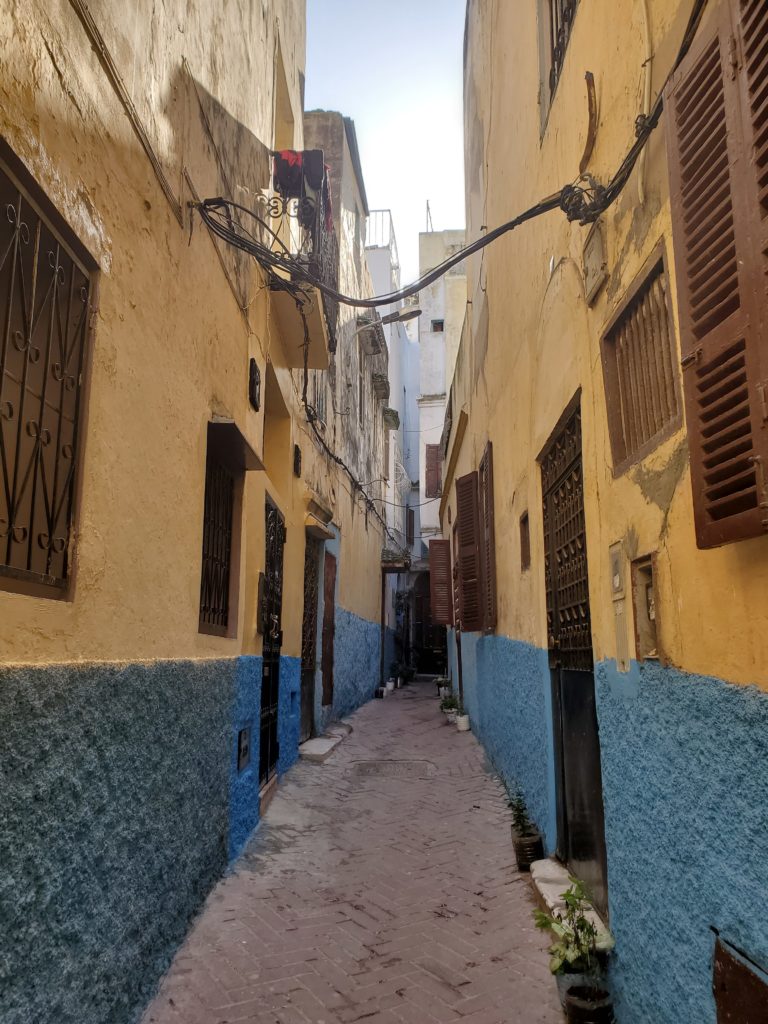


The medina is interesting in a chaotic way – mostly small stalls selling handicrafts, sports clothes, traditional women’s dresses, pointy bejeweled shoes, leather stuff, sundry goods, vegetables and fruit, bread and pastries, etc. But the hustle scene was jarring – even though I had read about it, experiencing it in person is something else. Pushy shopkeepers (all men) and their hangers on/accomplices calling out to me – greetings in one or more of English, French, Spanish, come into their store, where am I going? where am I from? am I lost? can they guide me around the city? I didn’t really feel concerned for my safety, it was just annoying.
I generally ignored them but in a weak moment chatted with a young guy and let him escort me to (what he said was) his father’s shop – “just for looking” – given tea and the hard sale began. Somehow, I later found myself the proud owner of a small Berber carpet and traditional long dress with a hood, actually a beautiful blue colour but I’m not sure I’ll get much of use out of in Vancouver! The young hustler scooped up my package and walked me back, insisting on a tip for his services on top of it all! At this point I realized my phone battery was dead and I had no way to find my way back through the maze to my hotel alone, so I did tip him a little (while he argued for more). I was relieved to finally get back to the riad and chalked up lesson two of the day in the art of the Moroccan commerce. But apart from having a lighter wallet than I expected I was not any worse for wear, and considered it a schooling in the local ways. At least it was a purchase rich in relationship, and I have to hand it to them, they have the art of a sale down to a science.
Thus was my first evening in Morocco. Although educational, I realized I needed to get my defenses up quickly and dial back on my “polite Canadian” program.
The next day my host took me on a drive to see a few sights around the city (at no charge). We visited a mosque-shaped lighthouse near where the Mediterranean and the Atlantic ocean meet. Next stop, the “Grotte d’Hercule“, naturally formed sea caves with human use dating to 6000BC that have been enlarged by the Berber people to make milling stones – the scalloped inner surface of the caves is the result. Random fact: Def Leppard played here in 1995, becoming the first rock band to play three continents in a single day (thanks Wikipedi)!
After returning to the riad, I explored the medina some more, and managed to get laundry done in one of the kiosks, and found a lovely little restaurant tucked in a hidden corner.



Despite the scenery I admit I wasn’t feeling too excited after the medina experience and considered retreating to Spain! This seems funny to me now, just a few days later. Luckily I took my host’s advice instead and took a trip to Chefchaouen, and made a plan to head to Fes after that.
The bus station is about 5 km from my hotel so I cycled there – my first ride in Morocco, as the medina alleys are too narrow for actual riding and there’s nowhere to park my bike if I want to buy stuff. Ahhhh – again, such a liberating feeling, to be moving freely under my own power and direction! Outside the medina, and on my bike, I wasn’t hassled at all. Unsurprisingly, there are no bike lanes, so I carefully navigated on both sidewalks and the road, depending on the situation. Traffic is a bit chaotic, but it wasn’t heavy so it wasn’t too bad.
I got quite a few surprised looks and approving comments from guys about my rig, especially when they saw me fold and unfold it. The first time I was asked how much it cost (a common question, I discovered) by the men at the baggage area of the bus station, I answered straight up, which caused them to chatter excitedly about that for quite a while. A bit embarassed, after that I just said I didn’t know because I got it as a gift.
We drove an increasingly winding highway through lush rolling hills with olive trees, pasture lands and some forest, eventually arriving at Chefchaouen on a beautiful sunny day.
The bus stations are typically (I’m discovering) a little way outside the centre, and in this case that meant at the bottom of a steep hill, probably about 4000 vertical feet below the old part of the town. I was about to start riding (and pushing my bike, I only have four gears after all) but something had come loose in my drive train on the bus and rather than accepting the well meaning “help” of passing men not trained in bike mechanics, I took a taxi – which as it turned out was probably for the best.
So, the town, as you can see in these photos, is spectacular! And the people were friendly but not pushy. I was for the most part left alone to wander around and check out the sights, scents and scenes, chatted with a couple of the shopkeepers, walked up to a viewpoint to watch the sun set, and had a delicious authentic meal at an inconspicuous place recommended by my host. I stayed at a super charming hotel in this old part of the town, run by a friendly Columbian woman. Speaking Spanish with her totally confused me though, as I then ended up sometimes greeting others in Spanish by mistake, and mixing up the two languages.
Chefchaouen is quite popular with tourists from all over, it seemed. I met people from England, the Ukraine, and Spain, and saw a lot of Asians. But it’s also a real town, people of all ages going about their daily business, and seemed to have a nice balance of catering to tourism without being tacky. The other great thing, as with all the “old towns” I’ve visited on my trip, is the lack of cars. In this case it’s not only the narrow streets but also the topography – a lot of sets of stairs climbing the steep hillside – that keeps out virtually all vehicles except a few motorized delivery carts. It must be a difficult place to live if you are disabled thought – I saw quite a few elderly people walking slowly with canes but a wheelchair would not work.
At night I could hear only voices in the street, cats and dogs, and eventually almost nothing. In fact, the medinas are quieter than the European historical centres I visited, I figure due to the lack of drinking in Muslim culture. Eventually the sound of the calls to prayer over loudspeakers echoed throughout the town, around 5 or 6am.

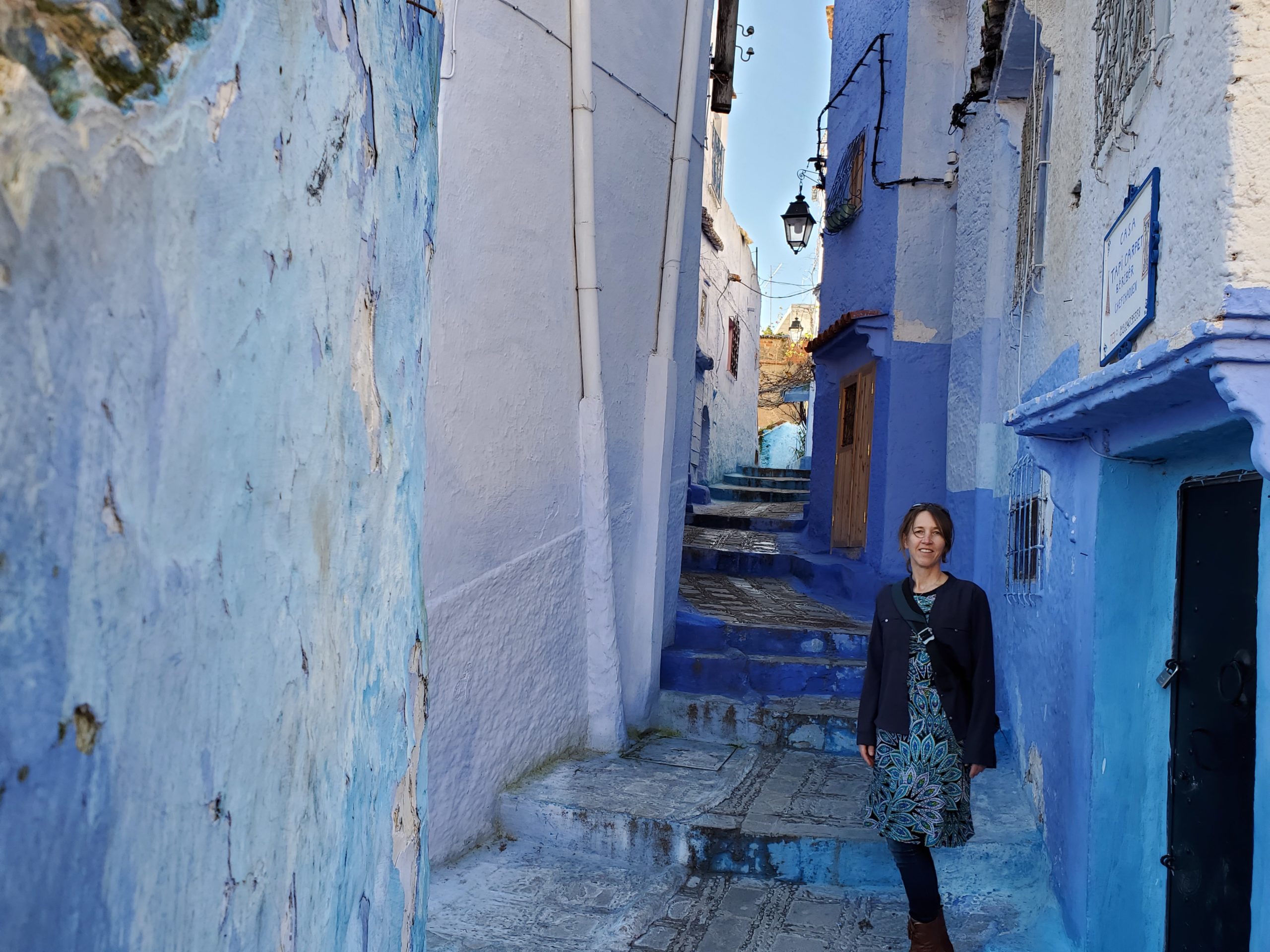



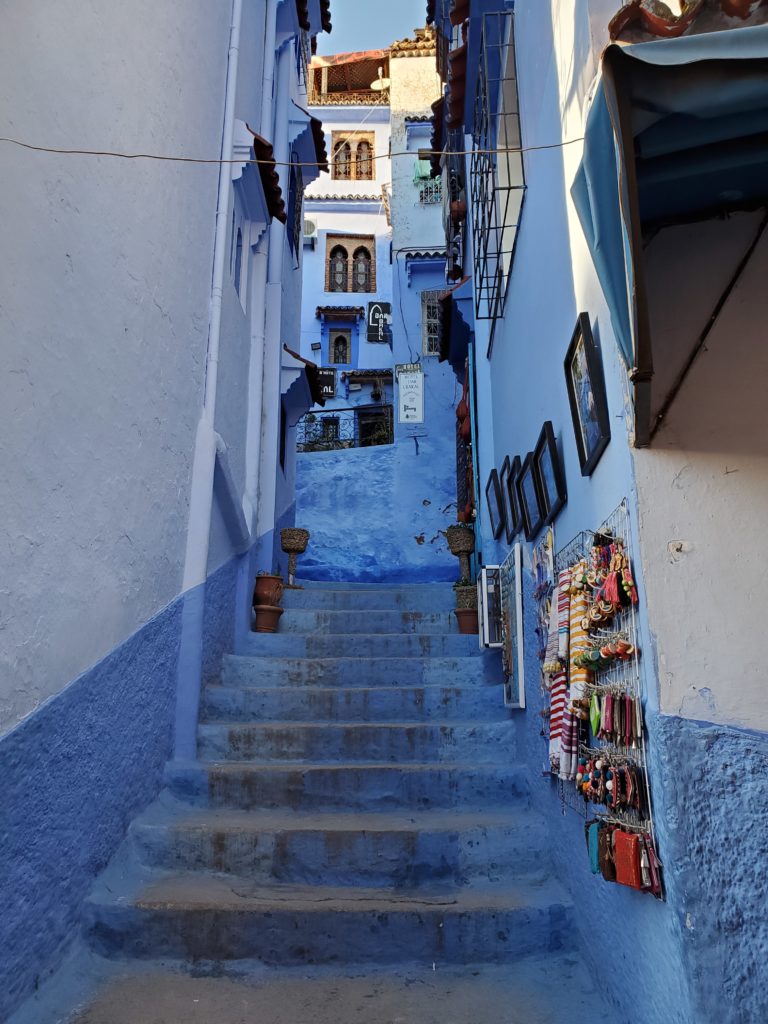
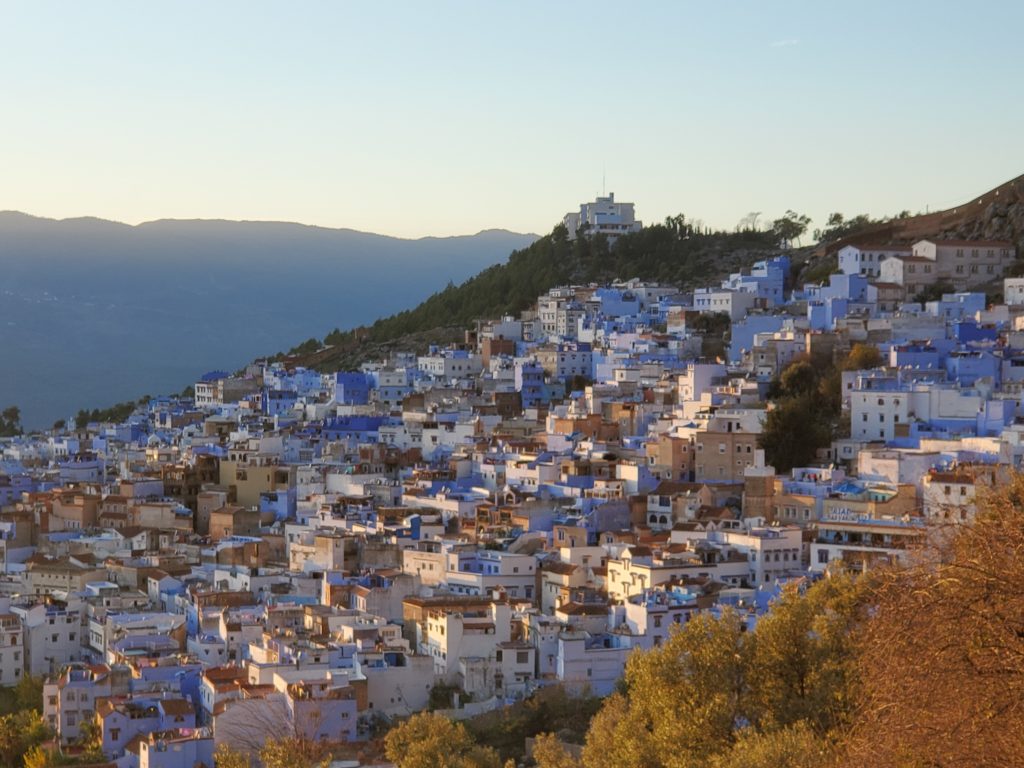
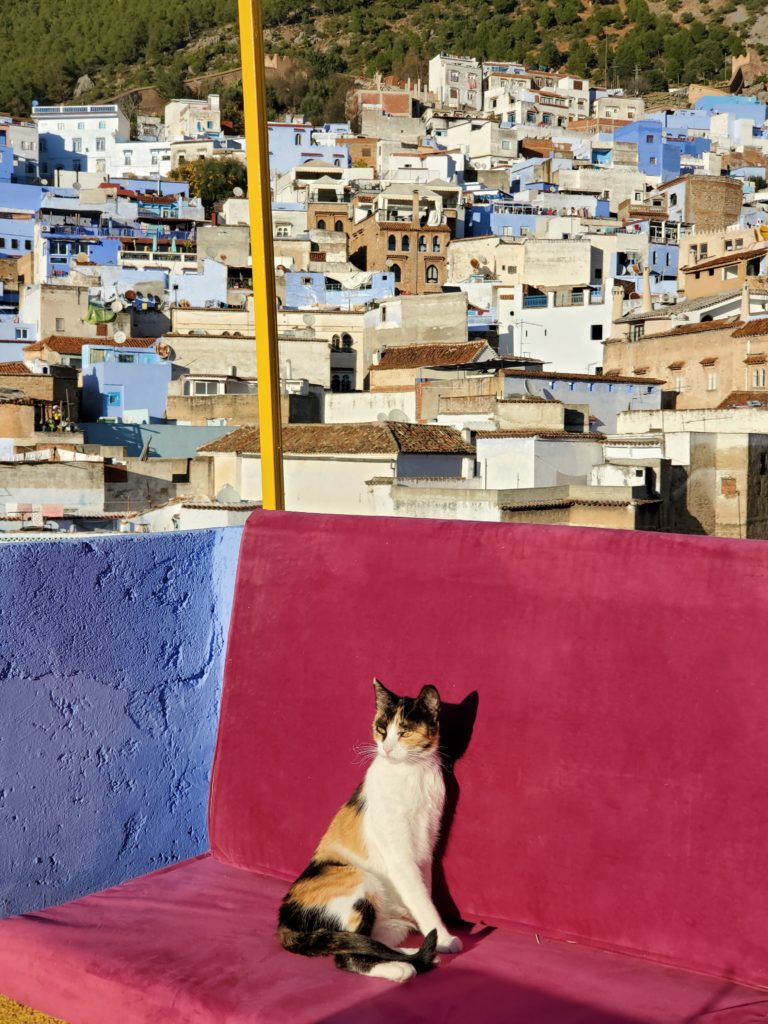









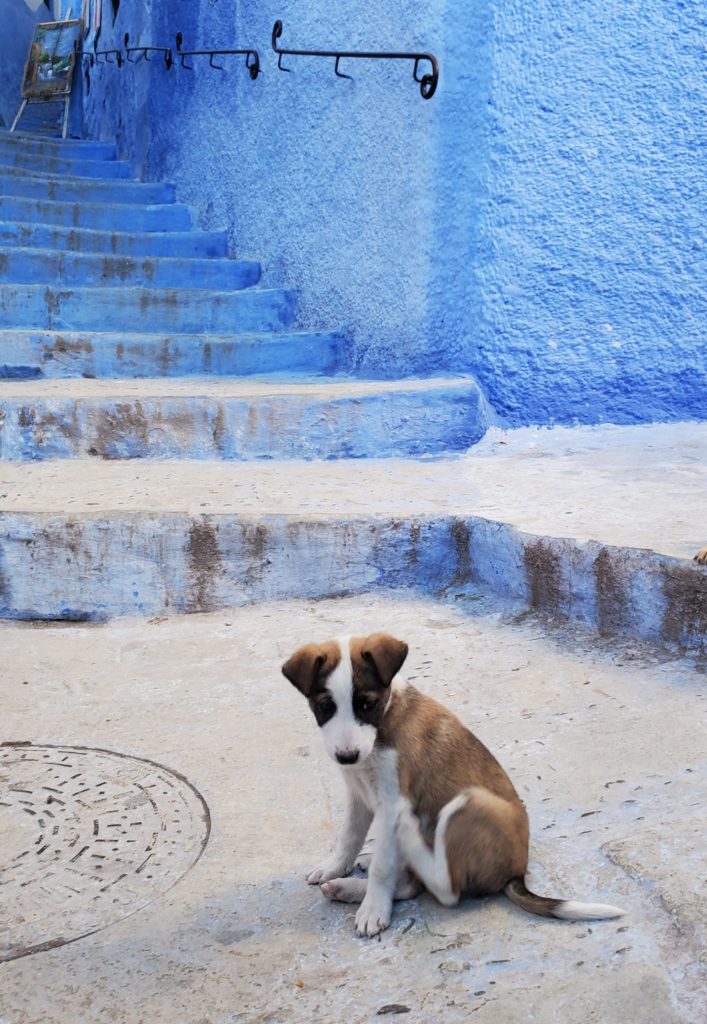
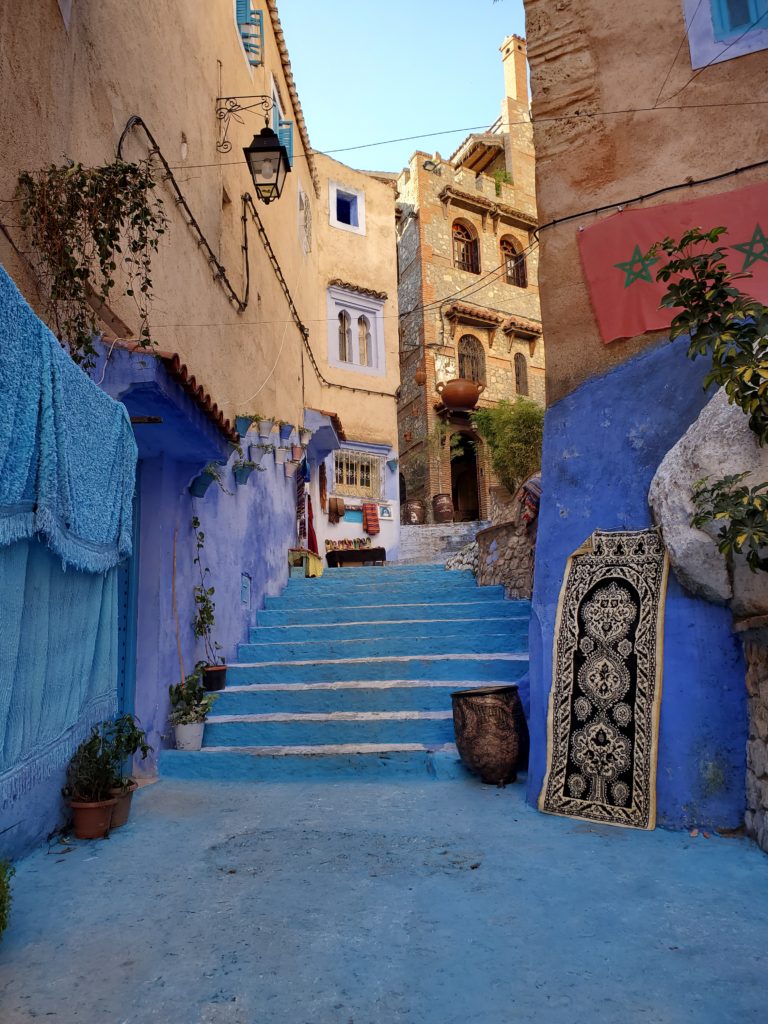
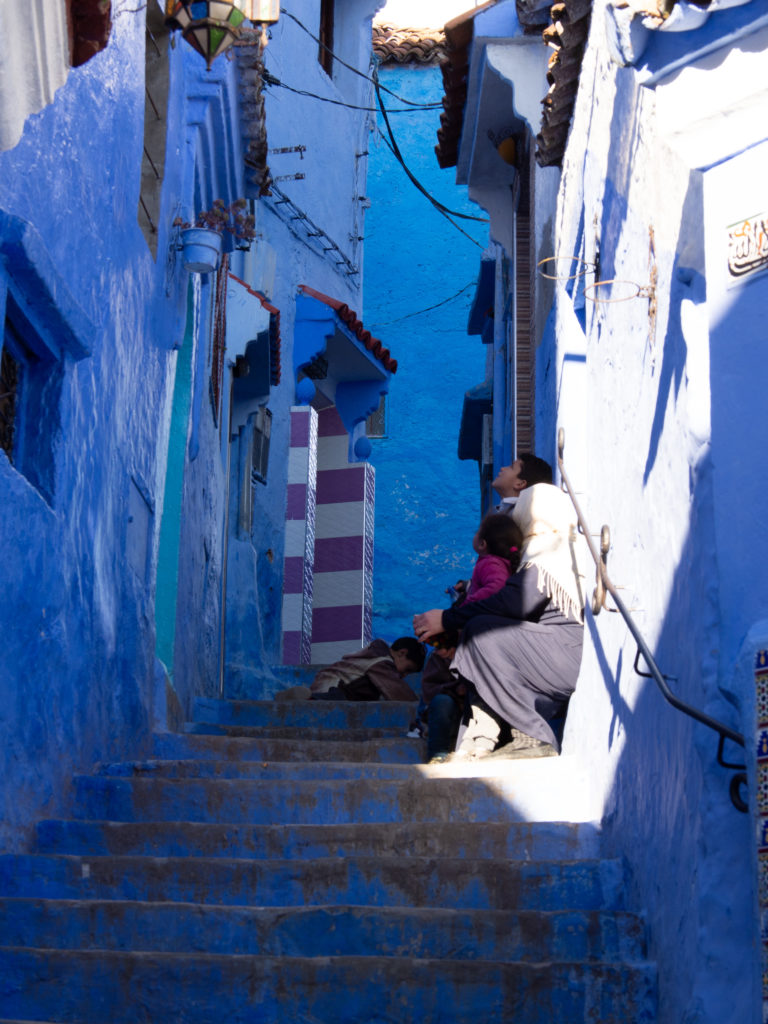




Wowza! Very picturesque, indeed!
Hi Lise
I got your Blog from Claire. I and your mum have been reading about your experiences, and you sure had lots of worth while experiences for your own self, your professional self, and ones that were enlightening for me. Just amazing! If you write any more I would appreciate being able to read that.
The picture of you with a hoody veiling part of your face and some hair showing makes you look life a professional pro, a mysterious lady with intelligence.
Bon voyage in all future ventures.
Regards, Frank